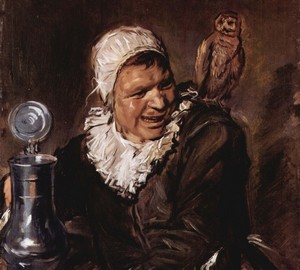
Description of the picture:
Malle Babbe – France Hals. Canvas, oil. 75 x 64 cm
Frans Hals has a lively and light style. Maybe that’s why he especially succeeded in portraits of ordinary people – street musicians, tipsy men, innkeepers, idle revelers, drunkards, gypsies and fishermen. He likes their cheerful attitude to life, simplicity and liveliness of emotions.
One of the characteristic, vibrant and very emotional works of Hals is the famous “Malle Babbe”, which has become the artist’s most recognizable painting.
According to the documents discovered, this woman actually lived in Haarlem, kept a tavern and in 1653 either was sent to prison, or to a correctional house, or to a monastery shelter.
But the talent of Hals is manifested in the fact that he knows how to distract from the appearance of his character (of course, while not losing similarity) and depicts the inner essence, his energy, his power of influencing his energy on others and the artist himself.
Barbara Klaas (Malle Babbe) was called a witch in Haarlem and was considered a witch. Well, judging by the portrait, she fully justified such a nickname.
An owl sitting on her shoulder and a jug of wine in her hand give her the appearance of a sort of sea pirate, not afraid of anything in the world.
The viewer fully reveals the character of the hostess of the tavern – prickly, reckless, wayward, but in an amazing way attractive and even endearing with his strength and unusualness.
With a sly glance, a large mouth is spread out in a frightening grin. Add to this the demonic laughter – hoarse and sinister, which she possessed and here is the “Harlem witch” in all its glory.
Facial features are not feminine at all. Malle Babbe is easier to imagine as a companion and drinking companion in the company of visitors to her establishment than as the guardian of the hearth.
Hals’s mastery is also manifested in the manner of execution – she is sweeping and confident. How easy it is to imagine the author of a picture in his work, his quick and free brush movements, strokes striving to capture the elusive moments of facial expressions or a particularly characteristic look. Using this method of writing, it may seem that the work will create a feeling of incompleteness, but this is not – the portrait is incredibly harmonious.
And thanks to the sharp eye of the artist, his talent, a colorful, spectacular and vibrant genre scene emerges from the life of the village people in front of the audience. The genius of Halsa is that the viewer stops and stares at this frighteningly ugly, ominously cheerful old woman-innkeeper, on whose shoulder a night bird sits."